This document provides an overview of cognitive therapy. It discusses Aaron Beck, the founder of cognitive therapy, and his background and influences. Beck developed cognitive therapy in the 1960s as an alternative to psychoanalysis, focusing on how a person's thinking affects their feelings and behaviors. Cognitive therapy views psychological disorders as stemming from dysfunctional thought patterns and cognitive distortions, rather than underlying unconscious desires. The document outlines seven common cognitive distortions identified by Beck and discusses how cognitive therapy aims to identify and change faulty assumptions and core beliefs through restructuring distorted thinking.
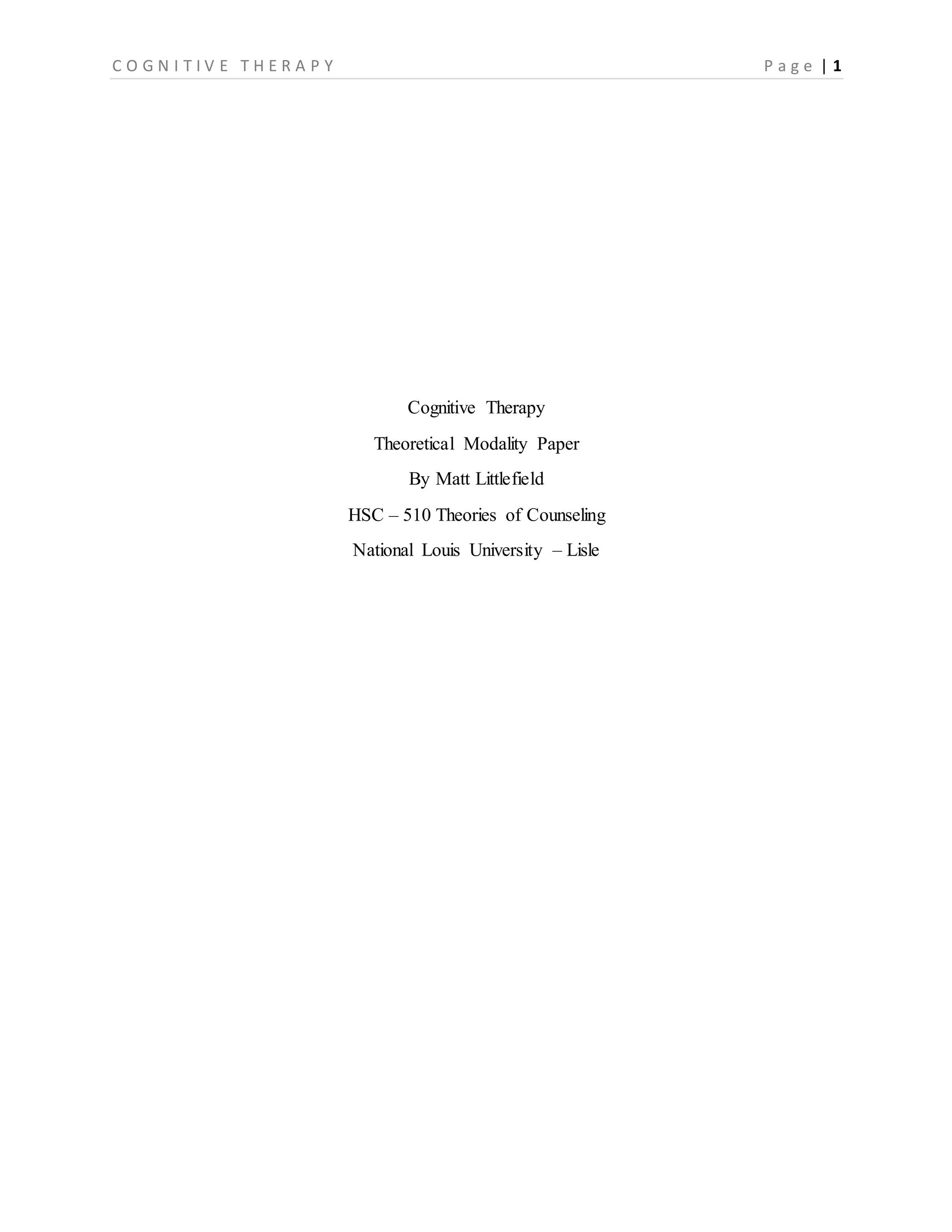
![C O G N I T I V E T H E R A P Y P a g e | 2
Abstract
While learning about the different kinds of theoretical orientations to psychotherapy, I was both
inspired and anxious about choosing only one that best fits my persona. After a great deal of
reflection and deliberation, I have chosen to focus on Cognitive therapy [CT]. Even though CT
utilizes some behavioral techniques, and can also be referred to as Cognitive Behavioral Therapy
[CBT], for simplicity’s sake, I will refer only to CT throughout this paper. It best fits my
personality in part due to the importance placed on the quality of the client-therapist relationship.
CT also fits the way I look at people in need of help. I do not see people as whatever their
possible technical diagnosis might be; I see them as suffering from symptoms largely due to
erroneous beliefs about themselves and cognitive misinterpretations regarding their life
experiences. This paper explores various sources, in order to present the historical background
and founder, view of human nature in relation to the client-therapist relationship, main
interventions utilized, and specific reasons why I chose the CT modality. I will also portray my
own personal theory of counseling by taking the liberty of employing what I view as the best
techniques from other modalities.](https://image.slidesharecdn.com/99b83f78-6a60-401b-b129-80e9d0ff28b9-151202035834-lva1-app6892/75/CT-Paper-2-2048.jpg)
![C O G N I T I V E T H E R A P Y P a g e | 3
Cognitive Therapy
“I think, therefore I am” is perhaps the most famous quote about cognition in the history
of the world (Descartes, 1637). In a preview of his recent book titled The Gap: The Science of
What Separates Us From Other Animals, Thomas Suddendorf states that he has repeatedly
“found two major features that set us apart: our open-ended ability to imagine and reflect on
different situations, and our deep-seated drive to link our scenario-building minds together”
(Suddendorf, 2014). He went on to assert that development of these two qualities have turned
“memory into mental time travel, social cognition into theory of mind, problem solving into
abstract reasoning, social traditions into cumulative culture, and empathy into morality”
(Suddendorf, 2014).
Cognitive therapy [CT] best fits my persona because it addresses thinking and how it
affects feeling and doing. CT allows the client to become empowered by taking an active role in
achieving insight into why one thinks in a certain way. The client is not considered sick or ill,
but rather as suffering from dysfunctional thinking by way of making flawed interpretations of
events. Just like when you hear the same song repeated over-and-over, self-defeating, negative,
and inaccurate thoughts can play on-an-on in one’s mind. If one repeats something harmful over
a long period of time, even if it is absolutely not based in fact, one can start to believe it as fact.
The main objective of this paper is to detail what makes CT unique among the many
modalities. I will also describe why I have chosen to focus on this model primarily, although I
do plan to use effective tools from other theories whenever appropriate. CT has proven to be
effective and popular among therapists within the counseling community. According to Corey
(2015), CT has become “one of the most influential and empirically validated approaches to
psychotherapy” (p. 289).](https://image.slidesharecdn.com/99b83f78-6a60-401b-b129-80e9d0ff28b9-151202035834-lva1-app6892/75/CT-Paper-3-2048.jpg)
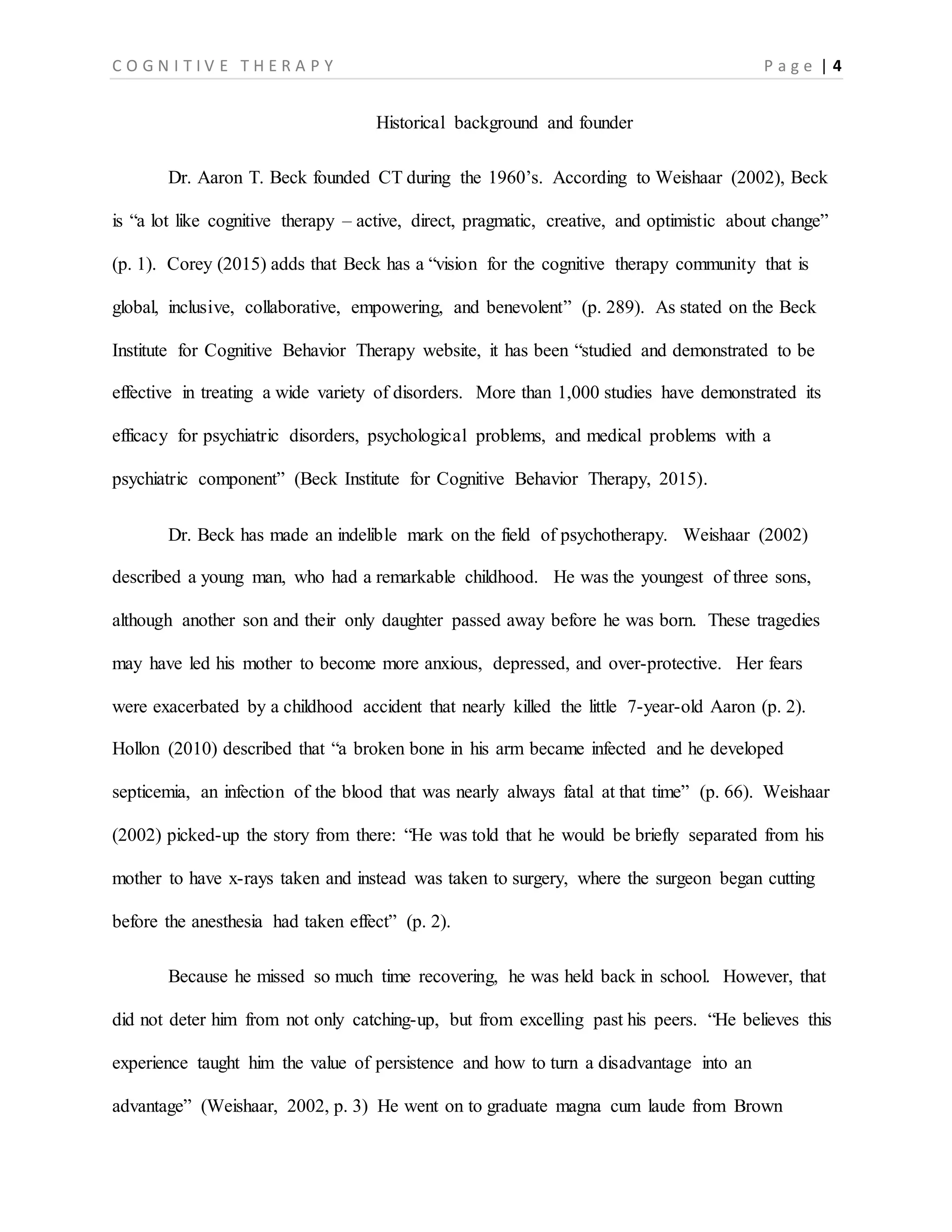
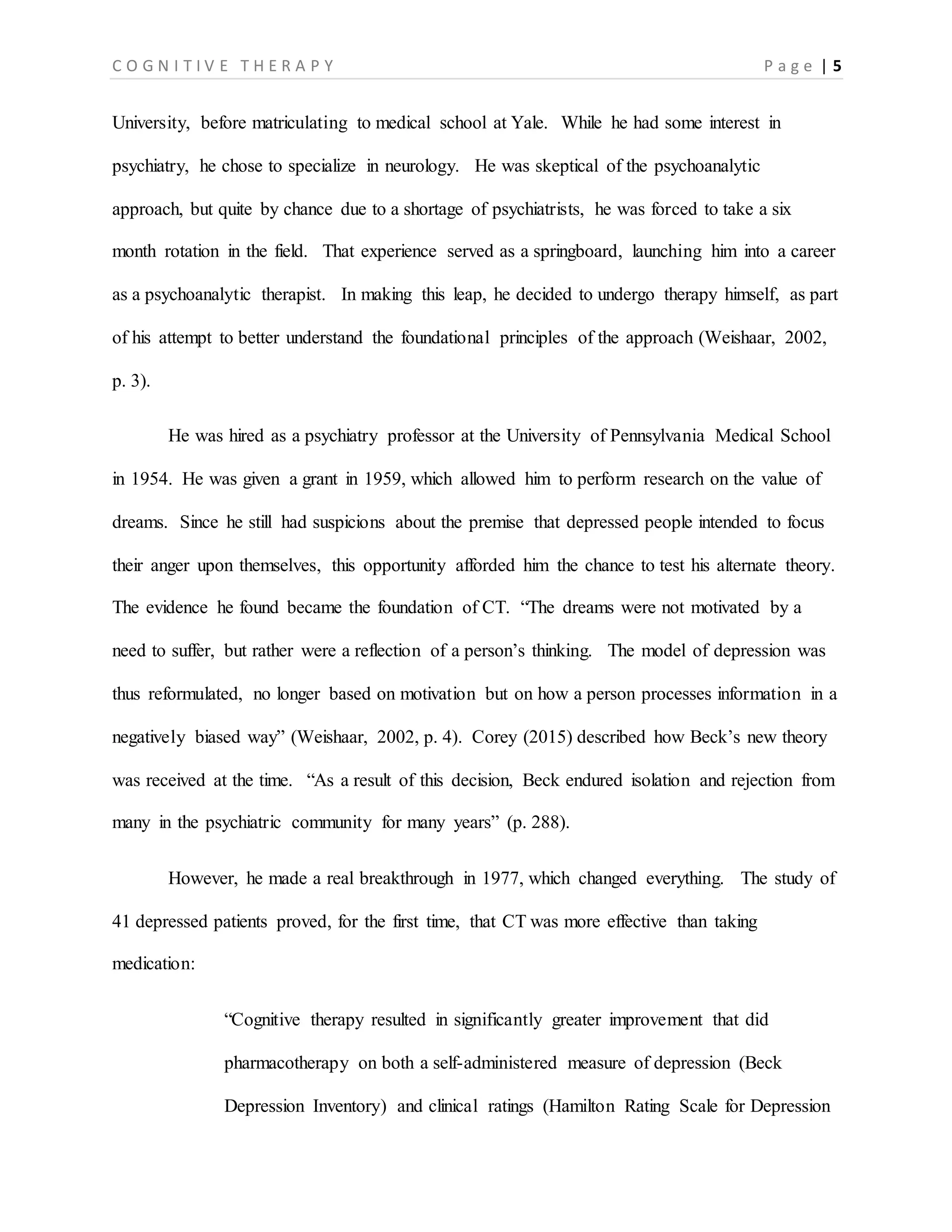
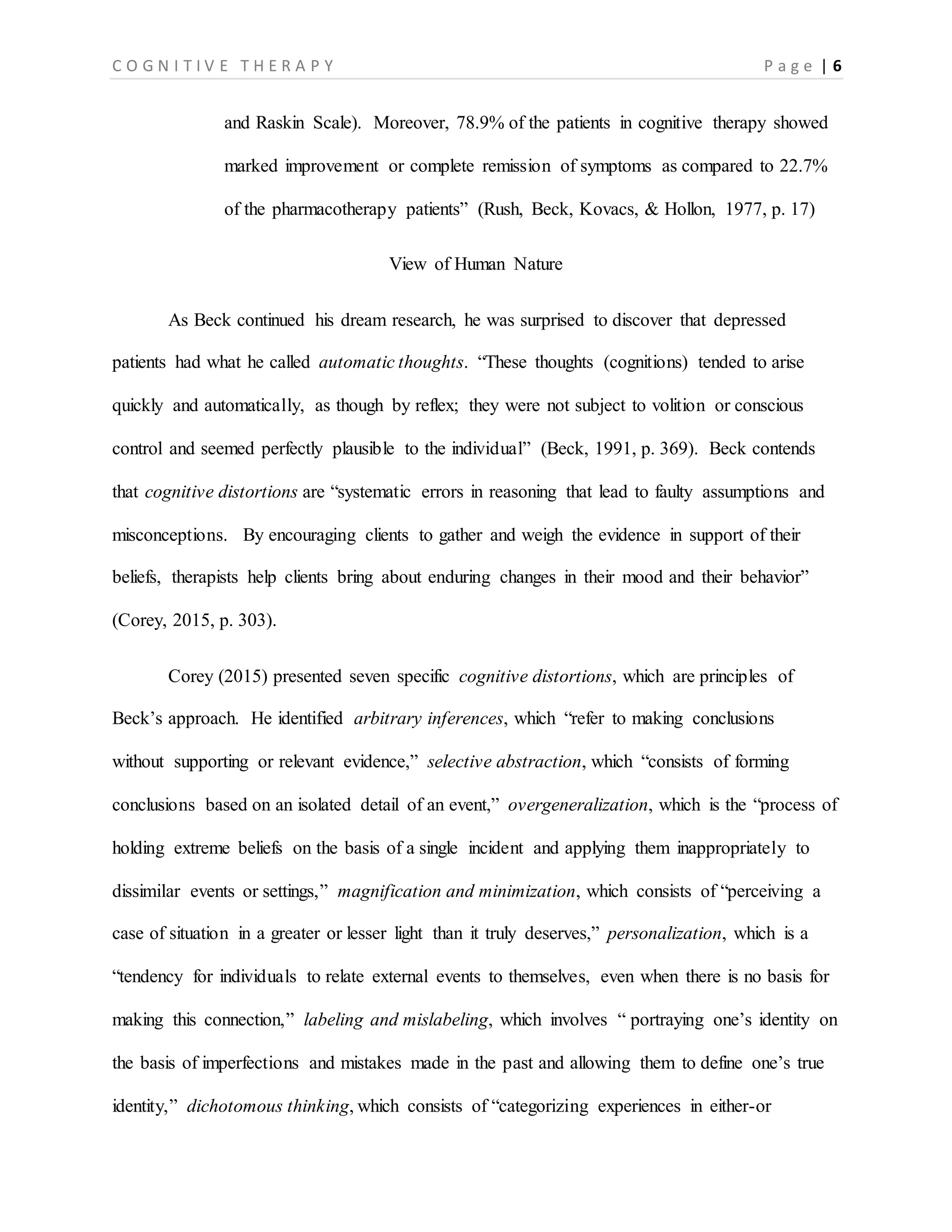
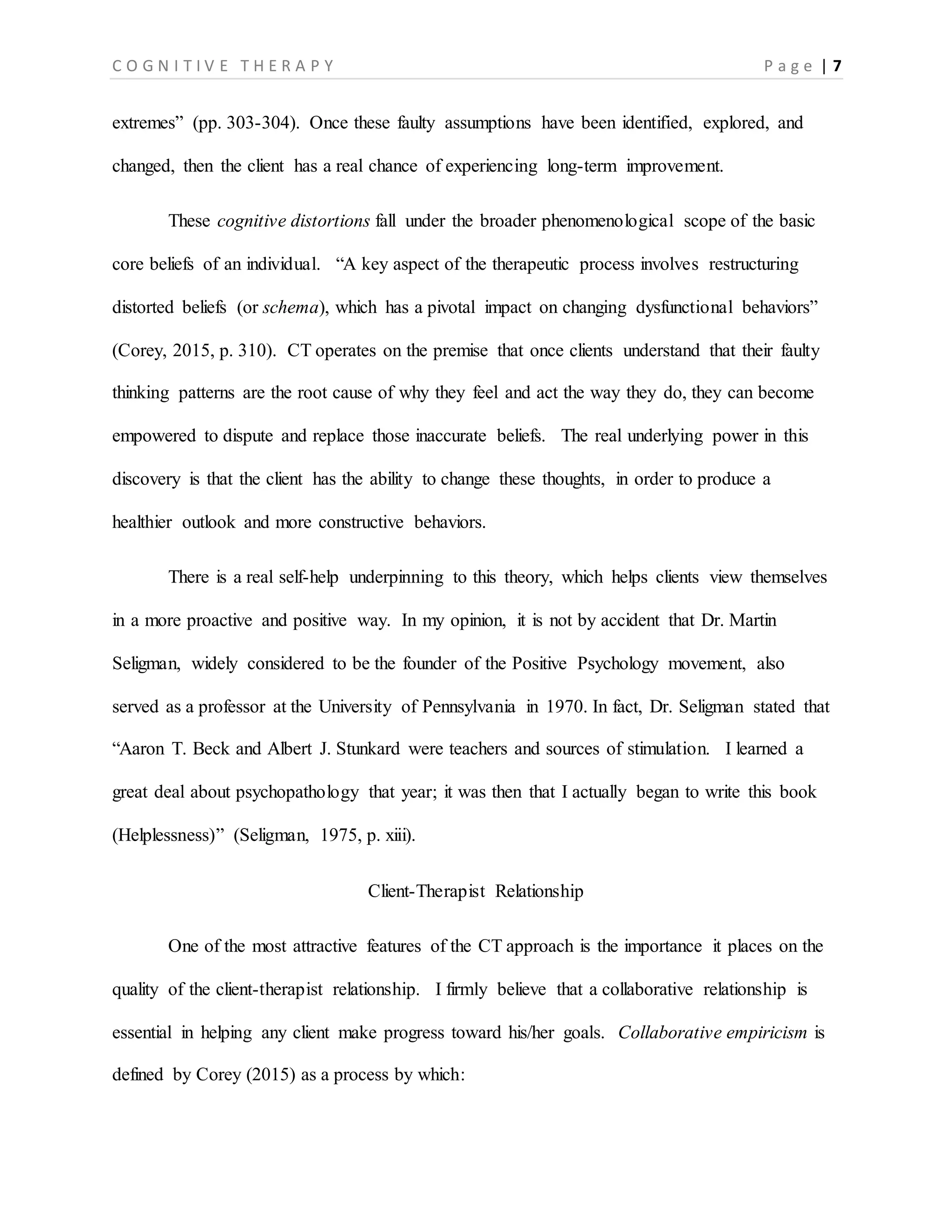


![C O G N I T I V E T H E R A P Y P a g e | 10
medical illnesses, crisis intervention, child abusers, divorce counseling, skills training, and stress
management. It has also succeeded not only with individuals, but also with couples and families
(p. 307).
Conclusion
I am most impressed with the evidence-based success of CT, the way clients are viewed,
how they are treated, and due to the common-sense techniques used to elicit change. I place a
premium on addressing the thinking construct first, in order to bring about healthier behaviors
and more positive feelings within the client. I get excited thinking about collaborating on plans
with my clients, so that they can come to believe more in their capacity to change for the better.
My plan is to use the Motivational Interviewing [MI] technique with teenagers and young adults,
but more of a Socratic dialogue with older adults.
It was still a difficult decision for me to choose only one theoretical modality to focus on,
because I see the value in parts of other psychotherapies. I was also drawn to consider Adlerian,
Existentialism, Person-Centered, Gestalt, and Reality therapy approaches due to their belief in
the power of the client-therapist relationship. I was not surprised to read that Adler was one of
the primary influences on Beck during the 1960’s. I really admire their view of clients, the
flexibility with which they can tailor specific techniques to clients, the focus on turning insight
into action, and their curiosity in birth order.
When it came down to the finish line, Gestalt therapy finished a close second for me.
The here and now, what and how, unfinished business, nonverbal cues, importance of awareness,
choice, and responsibility all made a powerful impression on me. However, I found that I really](https://image.slidesharecdn.com/99b83f78-6a60-401b-b129-80e9d0ff28b9-151202035834-lva1-app6892/75/CT-Paper-10-2048.jpg)
![C O G N I T I V E T H E R A P Y P a g e | 11
find it valuable to also explore the ‘why’ of issues. It may very well be that someone might
mistake me for a Gestalt therapist someday and that would be just fine with me, too.
While I appreciate the search for meaning, the awareness, freedom, and personal
responsibility, and the belief that we are constantly recreating ourselves in the Existential model,
I feel that I can employ those issues via CT. My personal experience with the Person-Centered
approach leads me to want to use this as a technique in crisis situations, especially. Reality
therapy is intriguing to me due to the WDEP framework and the value placed on choice theory.
Surprisingly, I also found that the Feminist analysis of both the gender and power roles has value
for me to consider exploring whenever appropriate.
Since I have always had an interest in positive psychology, I plan to incorporate
optimism into my therapeutic approach. I also plan to study Dialectical Behavior Therapy
[DBT], Mindfulness-Based Stress Reduction [MBSR], Mindfulness-Based Cognitive Therapy
[MBCT], and Acceptance and Commitment Therapy [ACT] further. I have found peace and
comfort through prayer, meditation, guided mediation, and yoga, so I would like to learn more
about those approaches. I am looking forward to crafting my own perspective through more
research and reflection on my values.](https://image.slidesharecdn.com/99b83f78-6a60-401b-b129-80e9d0ff28b9-151202035834-lva1-app6892/75/CT-Paper-11-2048.jpg)
![C O G N I T I V E T H E R A P Y P a g e | 12
References
BeckInstitute forCognitive BehaviorTherapy.(2015,November16). History of CBT. RetrievedfromBeck
Institute forCognitiveBehaviorTherapy:http://www.beckinstitute.org/about-beck/our-
history/history-of-cognitive-therapy/
Beck,A. (1991). Cognitive Therapy:a30-Year Retrospective. American Psychologist,46(4),368-375.
Corey,G. (2015). Theory and practice of counseling and psychotherapy (9th ed.). Belmont,CA:
Brooks/Cole CengageLearning.
Descartes,R.(1637). Discourseon Method of Rightly Conducting One’sReason and of Seeking theTruth
in the Sciences.
Hollon,S.(2010). Aaron T. Beck:The cognitive revolutionintheory andtherapy.InS.Hollon, Bringing
psychotherapyresearch to life (pp.63-74).
McGinn, L. (2000). Cognitive Behavioral Therapyof Depression:Theory,Treatment,andEmpirical Status.
American Journalof Psychotherapy,54(2),257-262.
Norcross,J.,& Lambert,M. (2014). RelationshipScience andPractice inPsychotherapy:Closing
Commentary. Psychotherapy,51(3),398-403.
Rush,A.,Beck,A., Kovacs,M., & Hollon,S.(1977). Comparative Efficacyof Cognitive Therapyand
Pharmacotherapyinthe Treatmentof DepressedOutpatients[Abstract]. CognitiveTherapy and
Research,1(1), 17-37.
Seligman,M.(1975). Preface.InM. Seligman, Helplessness:on depression, development,and death (p.
xiii).SanFrancisco,CA:W.H.Freeman& Co.
Suddendorf,T.(2014, March 3). Whatseparatesusfromthe animals? RetrievedfromSlate.com:
http://www.slate.com/articles/health_and_science/science/2014/03/the_science_of_what_sep
arates_us_from_other_animals_human_imagination_and.single.html
Weishaar,M. (2002). The Life of Aaron T. BeckMD [Prologue].InR.Leahy,&E. Dowd, Clinical Advances
in CognitivePsychotherapy:Theory and Application (pp.1-11).New York,NY:SpringerPublishing
CompanyInc.](https://image.slidesharecdn.com/99b83f78-6a60-401b-b129-80e9d0ff28b9-151202035834-lva1-app6892/75/CT-Paper-12-2048.jpg)